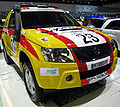2007 Suzuki Grand Vitara Owner's Manual - Page 167
2007 Suzuki Grand Vitara Manual
Page 167 highlights
INSPECTION AND MAINTENANCE D. Construction Code This letter code is used to indicate the type of ply construction in the tire. The letter "R" means radial ply tire construction, the letter "D" means diagonal or bias ply construction, and the letter "B" means belted-bias ply construction. E. Rim Diameter This two-digit number is the wheel or rim diameter in inches. Tire Inflation Pressure Tire inflation pressure should be checked when the tire is cold. "Cold tire inflation pressure" is the pressure in a tire that has been driven less than 1 mile (1.6 km) or has been standing for three hours or more. Recommended Cold Tire Inflation Pressures Front Tires Rear Tires Spare 220 kPa 32 psi 220 kPa 32 psi 220 kPa 32 psi WARNING Your SUZUKI is equipped with tires which are all the same type and size. This is important to ensure proper steering and handling of the vehicle. Never mix tires of different size or type on the four wheels of your vehicle. Mixing tires could cause you to lose control while driving which may lead to an accident. The size and type of tires used should be only those approved by SUZUKI Motor Corporation as standard or optional equipment for your vehicle. 54G307 The front, rear and spare tire pressure specifications for your vehicle are shown below and are listed on the Tire and Loading Information Label, which is located on the driver's door lock pillar. The Tire and Loading Information Label contains the following information: • Seating Capacity • Maximum Allowed Combined Weight of Occupants and Cargo • Original Tire Size • Recommended Cold Tire Inflation Pressure of Original Tires Measuring air pressure Use the following steps to achieve proper tire inflation: 1) Identify the recommended tire pressure on the vehicle's Tire and Loading Information Label or in the owner's manual. 2) Remove the valve cap from the tire valve stem. 3) Using a reliable pressure gauge, measure the tire inflation pressure by pressing the tire gauge firmly onto the valve to get a pressure measurement. Remember that inflation pressures should be checked when the tires are "cold", meaning before they have been driven one mile or after sitting for three hours or more allowing the tire to cool to ambient air temperature. 4) If the air pressure is too high, slowly release the air by pressing on the tire valve stem with the edge of the tire gauge until you reach the correct pressure. 9-26
















